

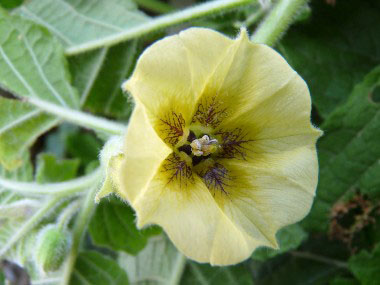
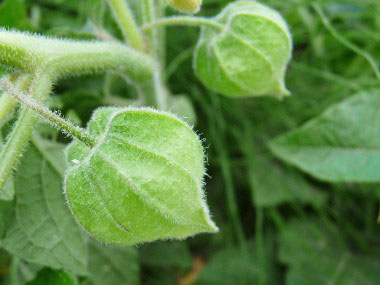
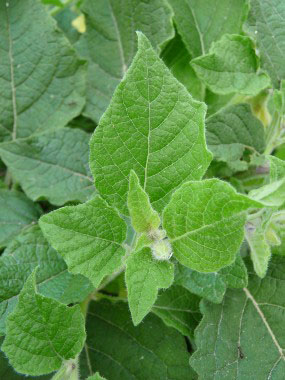
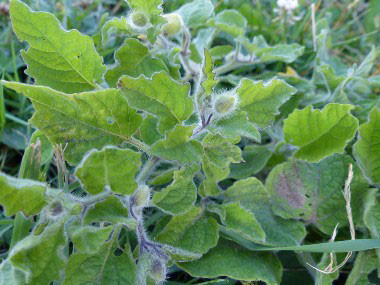
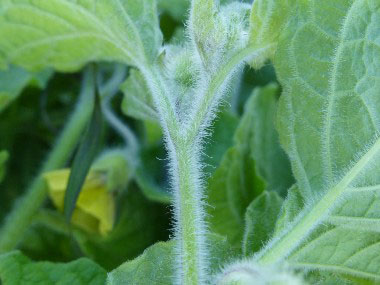
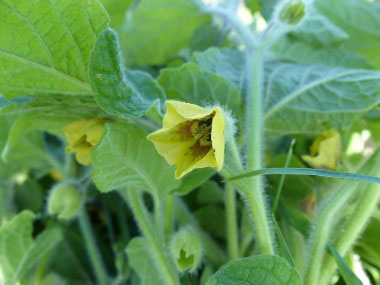
To support our efforts please browse our store (books with health benefits, etc.).
The ground cherry is a widespread native plant which is considered a weed in many areas. It is a member of the nightshade (Solanaceae) family and as such, only the ripe berries are edible - all other parts of this plant are toxic! Sometimes finding a significant amount of ripened berries is difficult because they are also enjoyed by wild turkeys, quail, opossums, skunks, and apparently a couple of species of turtles as well.Interestingly, the ground cherry is closely related to the tomatillo According to a few sources, the ground cherry has not been definitively placed into the category of being a fruit or vegetable; however many consider this a berry (fruit). There are approximately thirty different species of this plant throughout most of the US and Canada. The species are not always easy to tell apart, and there is not full agreement on species boundaries. Some common names include lanceleaf groundcherry, hog plum, Virginia ground cherry, and husk The Chinese lantern plant is in the same family.
Distinguishing Features
Ground cherry plants are very easy to spot if you know what a Chinese lantern or a tomatillo plant looks like. The ground cherry grows on an erect, somewhat vining plant that can get to almost 1 metre (3') in height. It has purplish spreading branches and slightly velvety leaves, similar to those on a tomatillo. The ground cherry is wrapped in a thin, straw-coloured, parchment-like husk. Inside, the berries are an orange-yellow hue and have a smooth, almost waxy sheen. Their inner juicy pulp contains numerous very small yellowish seeds which are entirely edible and offer a crunchy texture.
Flowers
The flowers are funnel shaped, drooping singly where three stems or leaves meet; yellow with a star-shaped dark purplish (lighter colour in the clammy ground-cherry) centre. Flowers typically measure about 2.7 cm wide (slightly more than one inch). Flower pedicels measure about 1.5 cm long and elongate to 2.5 cm after fruit formation. Flowering begins about six weeks after the plant emerges and continues up to September. The fruits are loosely enclosed by the much enlarged calyx. The calyx becomes paper-like. Each fruit contains about 255 and 155 seeds.
 Fields
of Nutrition has medicinal benefits and vitamin/mineral content of Ground Cherry.
Fields
of Nutrition has medicinal benefits and vitamin/mineral content of Ground Cherry.
Leaves
The palish green leaves are arranged alternately on the stems, are oval or lance-shaped, and they havetoothed or entire margins. There is one leaf per node along the stem.
Height
The stems of this plant can produce several branches. They tend to be erect with some attaining hights up to 90cm (about 32"). The clammy ground-cherry plant is generally shorter (20-25").
Habitat
Ground cherries are considered anthropogenic, meaning they can grow in man-made or disturbed habitats. They also can be found in fields and along woodlands. woodlands. Depending on the spefic species of the ground cherry determines which one may grow in certain geographic areas. They can be located in full to partial sun areas, mesic to dry conditions, and in soil containing loam, clay-loam, sand, gravel, or rocky material.
Edible Parts
Only ripe (yellow-orange) berries are safe to consume. The calyx must be removed. Unripe berries can cause diarrhea, vomiting or stomach upset. Once ripe, the ground cherries contain vitamin A, B3 and vitamin C. Due to being a close cousin of the tomatillo, their taste is quite similar. Many claim the ripe berry tastes better after a light frost.
Other Name
Virginia Ground Cherry.
Similar Plants
Clammy Ground Cherry.
Winter Survival Food Handbook

PDF Plant Magazines
Types of Wild Food
Geographic Zones Seasons
Disclaimer
EdibleWildFood.com is informational in nature. While we strive to be 100% accurate, it is solely up to the reader to ensure proper plant identification. Some wild plants are poisonous or can have serious adverse health effects.
We are not health professionals, medical doctors, nor are we nutritionists. It is up to the reader to verify nutritional information and health benefits with qualified professionals for all edible plants listed in this web site. Please click here for more information.
Why Edible Wild Food?
- Food costs are rising
- Free, wild food is readily abundant
- Wild food adds nutrition to your diet
- Wild food can help treat various medical conditions





